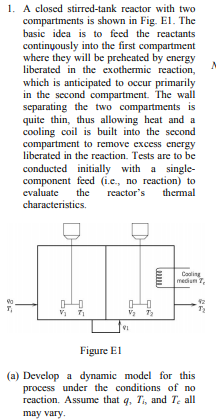1. A closed stirred-tank reactor with two compartments is shown in Fig. El. The basic idea s to feed the reactants continuously into the first compartment where they will be preheated by energy liberated in the exothermic reaction, in the second compartment. The wall separating the two compartments is quite thin, thus allowing heat and a cooling coil is built into the second liberated in the reaction. Tests are to be component feed ie, no reaction) to evaluate the reactor's thermal Figure El (a) Develop a dynamic model for this process under the conditions of no reaction. Assume that q, Ti, and Te all
1. A closed stirred-tank reactor with two compartments is shown in Fig. El. The basic idea s to feed the reactants continuously into the first compartment where they will be preheated by energy liberated in the exothermic reaction, in the second compartment. The wall separating the two compartments is quite thin, thus allowing heat and a cooling coil is built into the second liberated in the reaction. Tests are to be component feed ie, no reaction) to evaluate the reactor's thermal Figure El (a) Develop a dynamic model for this process under the conditions of no reaction. Assume that q, Ti, and Te all
Introduction to Chemical Engineering Thermodynamics
8th Edition
ISBN:9781259696527
Author:J.M. Smith Termodinamica en ingenieria quimica, Hendrick C Van Ness, Michael Abbott, Mark Swihart
Publisher:J.M. Smith Termodinamica en ingenieria quimica, Hendrick C Van Ness, Michael Abbott, Mark Swihart
Chapter1: Introduction
Section: Chapter Questions
Problem 1.1P
Related questions
Question
100%

Transcribed Image Text:1. A closed stirred-tank reactor with two
compartments is shown in Fig. El. The
basic idea s to feed the reactants
continuously into the first compartment
where they will be preheated by energy
liberated in the exothermic reaction,
in the second compartment. The wall
separating the two compartments is
quite thin, thus allowing heat and a
cooling coil is built into the second
liberated in the reaction. Tests are to be
component feed ie, no reaction) to
evaluate the reactor's thermal
Figure El
(a) Develop a dynamic model for this
process under the conditions of no
reaction. Assume that q, Ti, and Te all
Expert Solution
This question has been solved!
Explore an expertly crafted, step-by-step solution for a thorough understanding of key concepts.
This is a popular solution!
Trending now
This is a popular solution!
Step by step
Solved in 8 steps with 7 images

Recommended textbooks for you

Introduction to Chemical Engineering Thermodynami…
Chemical Engineering
ISBN:
9781259696527
Author:
J.M. Smith Termodinamica en ingenieria quimica, Hendrick C Van Ness, Michael Abbott, Mark Swihart
Publisher:
McGraw-Hill Education

Elementary Principles of Chemical Processes, Bind…
Chemical Engineering
ISBN:
9781118431221
Author:
Richard M. Felder, Ronald W. Rousseau, Lisa G. Bullard
Publisher:
WILEY

Elements of Chemical Reaction Engineering (5th Ed…
Chemical Engineering
ISBN:
9780133887518
Author:
H. Scott Fogler
Publisher:
Prentice Hall

Introduction to Chemical Engineering Thermodynami…
Chemical Engineering
ISBN:
9781259696527
Author:
J.M. Smith Termodinamica en ingenieria quimica, Hendrick C Van Ness, Michael Abbott, Mark Swihart
Publisher:
McGraw-Hill Education

Elementary Principles of Chemical Processes, Bind…
Chemical Engineering
ISBN:
9781118431221
Author:
Richard M. Felder, Ronald W. Rousseau, Lisa G. Bullard
Publisher:
WILEY

Elements of Chemical Reaction Engineering (5th Ed…
Chemical Engineering
ISBN:
9780133887518
Author:
H. Scott Fogler
Publisher:
Prentice Hall


Industrial Plastics: Theory and Applications
Chemical Engineering
ISBN:
9781285061238
Author:
Lokensgard, Erik
Publisher:
Delmar Cengage Learning

Unit Operations of Chemical Engineering
Chemical Engineering
ISBN:
9780072848236
Author:
Warren McCabe, Julian C. Smith, Peter Harriott
Publisher:
McGraw-Hill Companies, The